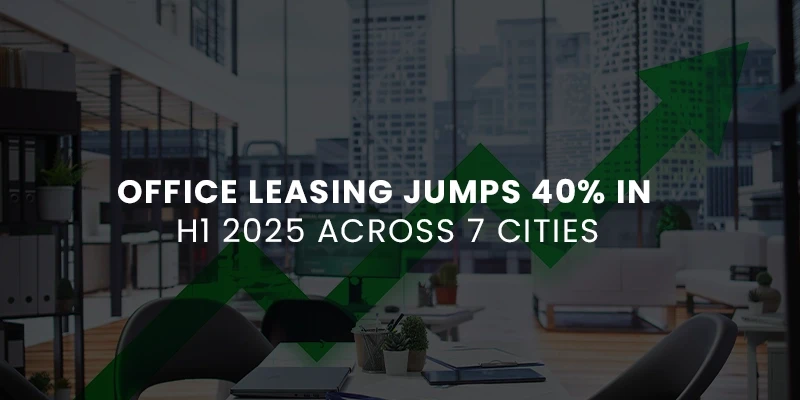Office Leasing Jumps 40% in H1 2025 Across 7 Cities
The first half of 2025 saw something remarkable in India’s commercial real estate. Net office leasing across the seven major cities surged 40% year-on-year, reaching about 26.8 million sq. ft. That’s not a small uptick—it’s a clear signal that businesses are on the move. Let’s dive into where, why, and what it means.
Growth of GCCs in H1 2025: India’s Biggest Driver
One of the main engines behind this boom? Global Capability Centres (GCCs). These strategic business hubs—servicing IT, BFSI, healthcare, and more—have been growing rapidly. In H1 2025 alone, GCCs leased approximately 15.2 million sq. ft., accounting for around 40% of overall leasing.
What’s pushing this? Corporates are seeking operational efficiency and global connectivity, and India offers exactly that: deep talent pools, cost benefits, improving infrastructure, and stable policies. It’s no surprise that GCCs are leading the charge.
Why 40% Growth? The Key Drivers
Tech and BFSI Momentum
Tech giants and BFSI firms together made up nearly half of all office deals. IT/ITeS accounted for 29%, coworking for 22%, and BFSI another 18% of leasing in H1 2025.
Robust Supply Lines
Developers added 24.5 million sq. ft. of new office supply—a 25% hike compared to last year.
Economic & Global Confidence
As domestic growth stabilizes and overseas uncertainty persists, India has become a go-to destination for long-term, strategic office commitments.
Flexible Workspace Boom
The flex and coworking segments are gaining traction. In Q2 alone, flexible spaces made up 19% of leasing and GCCs took a large slice—showing the rising popularity of adaptable work environments.
City-by-City Pulse Check
Bengaluru
Reigned supreme with 6.55 million sq. ft. leased—an impressive 64% jump YoY.
Pune
Rockstar of the half—leasing soared 188% to hit 3.8 million sq. ft.
Kolkata
The lone slowdown—absorption halved to 0.45 million sq. ft.
Mumbai
A strong performer with 4.5 million sq. ft. leased—a 43% YoY gain. Intriguingly, Malad–Goregaon led with 22% of the city’s share.
Delhi‑NCR, Chennai, Hyderabad
NCR posted a 7% rise. Hyderabad gained 35%, and Chennai grew 21%.
Mumbai Has Share of 22%—Here’s What It Really Means
When we say “Mumbai has 22% share,” we’re referring to micro-markets like Malad–Goregaon, which are outpacing other areas in office transactions. These nodes combined account for nearly a quarter of Mumbai’s leasing activity—a strong signal of where occupiers are choosing to locate their teams in the city.
This shift is meaningful: it speaks to affordable alternatives to core-BKC areas, better connectivity via new metro lines, and a new generation of Grade-A stock going up fast.
Rental Dynamics & Vacancy Trends
Rental Rates
Average rentals rose modestly—from ₹84 to ₹88 per sq. ft./month (+5%). Mumbai topped the chart with 12% rental growth, averaging ₹129/sq. ft.
Vacancy Rates
Slight decline from 16.7% to 16.3% overall. Hyderabad specifically saw a rise from 25.5% to 26.6%, reflecting some mismatch between supply and demand.
What This Means for You
If you’re a decision‑maker evaluating workspace in India—whether a start-up, GCC, or global corp—here’s what’s happening now:
Prime markets are compressing fast
With rising demand and limited completions in some cities (e.g., Bengaluru, Hyderabad), the hunt for scalable, managed office spaces is on.
Mumbai micro‑markets are gaining weight
Neighbourhoods like Malad–Goregaon are becoming major players. You can secure newer Grade‑A space without BKC premiums.
Flexibility is more valuable than ever
With coworking and managed offices cutting across sectors, scalability and service offerings matter more than just square feet.
Spotting future hubs early pays off
Cities like Pune and Chennai are now showing explosive growth. Being early can get you better rates and choices.
Final Take: What’s Next?
Here’s the bottom line:
- GCCs remain the primary growth engine, and their continued expansion in H1 2025 validates long-term demand.
- Mumbai’s 22% share in areas like Malad–Goregaon signals decentralization and opportunity.
- Rental and vacancy trends reinforce urgency—prime space is getting scarce fast, and demand is pulling rates up.
Curious about optimising your workspace strategy in this fast‑moving market?
Reach out, and let’s chat about your goals. We’ll align your needs with real‑time trends, so you can move fast—before the best spaces are gone.
